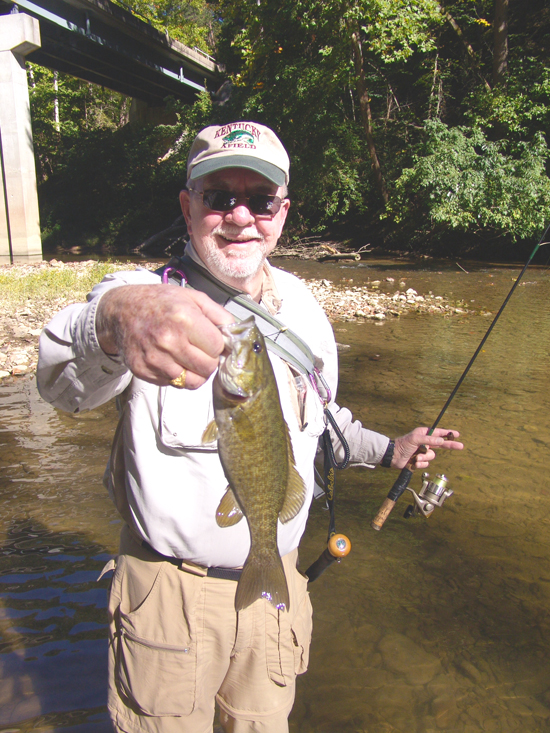
BY Lee McClellan
(July 19, 2018) – Those of us who wade rocky streams for smallmouth or tailwaters for trout sometimes bite off more than we can chew.
An eddy on the other side of the stream looks inviting and the more you stare at it, the more you want to cast there. The only problem is a waist-deep run with strong current lies between you and the enticing water.

You begin crossing the stream, but about half way, the current begins to push hard against your legs. You barely lift your foot and the current pushes it out from your body, nearly causing a fall. You look back and realize it will be just as hard to get back to where you started, as it will be to get to the other side of the stream.
You are stuck.
A wading staff will save your bacon in this situation. Made from aluminum, carbon fiber, crafted wood or a hickory stick, a wading staff gives anglers an extra balance point that can prevent a fall in sticky situations.
“I use my wading staff for balance whenever I wade,” said Dr. Larry Kelley of Richmond, retired assistant chair of nursing at Eastern Kentucky University. “It’s kept me from falling many times.”
Kelley also uses his wading staff, made from a cedar branch, to probe the water in front of him for depth. Clear water often looks shallower than it actually is and misjudgment can lead to a hat-floating, wader-filling mishap.
“This is another area where my wading staff is invaluable,” Kelley said. “It keeps me from making mistakes concerning the depth of a hole.”
This safety feature proves handy when wading cold tailwaters, like the Cumberland River below Wolf Creek Dam. The water temperatures in the Lake Cumberland tailwater run cold enough to induce hypothermia. Stepping off a shelf into water over your head quickly fills a set of waders. Waders filled with water become a dangerous weight in moving, cold water.
This is the reason wading anglers must always use a snug wading belt when wearing waders. The belt prevents the legs of the waders from quickly filling with water in the event of a fall.
You can use a wading staff to test the bottom composition before venturing into a hole. Muddy areas of the stream bottom often look like hard-packed sand, but are actually a gooey muck that can pull off your wading boots. Wading staffs are also invaluable in negotiating steep stream banks.
Some debate exists on whether wood, carbon fiber or aluminum make the best wading staff.
“I prefer a wooden staff because it floats behind me and out of the way when fishing,” Kelley said. “I can also quickly get the staff in my hand when I need it.”
You can make a wooden wading staff cheaply by finding a dense hickory or cedar branch stick about shoulder height. Rub in several coats of tung oil and let it cure.
Slide a piece of hypalon foam replacement handle for walking canes over the thickest end of the stick and glue if necessary. Drill a hole through the stick just above the handle. Work a large key ring though the hole to attach a lanyard system. Kelley uses a magnetic net release used by fly anglers to attach his wading staff to his vest via a carabiner.
Epoxy a rubber cane tip on the other end and you are in business. Some anglers epoxy a wrap of lead tape used on golf clubs just above the rubber protector to help weigh down the wooden staff in current.
Wood does not make fish spooking noises when contacting the stream bottom and possesses character that manufactured wading staffs lack.
However, a wooden staff does not collapse. Some anglers use collapsible ski poles or hiking staffs for wading staffs, but their thin bottom ends vibrate wildly in current.
The collapsible hiking staffs that use a twisting lock mechanism often freeze up after getting wet several times. The parts inside these staffs oxidize and all of the king’s money and all of the king’s men can’t get it separated again. This is incredibly frustrating if they lock up during a wading trip.
If you decide to use one of these for a wading staff, find one with a lever to lock and unlock the collapsible parts.
Some wading staffs use a piece of elastic cord in the middle to hold the pieces together, similar to a collapsible tent pole. These staffs fold up into a sheath for convenience. If these staffs get stuck in rocks on the bottom, they separate when pulled on, rendering them useless.
Higher-end trekking poles used for hiking have the elastic cord, but also a locking mechanism to keep them together during use. These make good wading staffs, but start at about $100.
Predictable water levels and hungry fish make late summer through late fall the best time to wade a stream. A wading staff makes wade fishing safer and more efficient.
Author Lee McClellan is a nationally award-winning associate editor for Kentucky Afield magazine, the official publication of the Kentucky Department of Fish and Wildlife Resources. He is a life-long hunter and angler, with a passion for smallmouth bass fishing.

X2-Cr�ftic alloy frame for increased corrosion resistance Carbon Matrix hybrid drag system for super smooth reliable drag performance
Technique: Baitcasting, Reel Size: LP, Reel Spool Material: Aluminum, Reel Handle Position: Right, Gear Ratio: 7.3:1, Retrieve Rate: 30″, Braking System: Magnetic, Bearing Count: 8, Braid Capacity (Yards/lbs): 190/20, 140/30, 100/50, Mono Capacity (Yards/lbs): 175/10, 145/12, 100/15, Drag Material: Carbon Fiber, Max Drag: 18 lbs., Drag Type: Star Drag, Anti Reverse: Instant Anti-Reverse, Weight: 7.94 oz.
Suggested retail is $105.95
Our price today limit supply
$89.95 Free shipping
After adding to the cart it will return you to the bottom of the page scroll to the bottom and hit the Paypal button


Be the first to comment